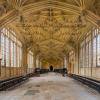Convocation House, 1634-7
Commentary
Images 1 and 2. The interior of Convocation House looking south and north, resp. 9 March 2015. Photos by David Iliff. Licence: CC-BY-SA 3.0. Source: Wikimedia Commons: 1 and 2.
Convocation is the name given to 'the great Congregation' including both regent and non-regent masters of the University, that is to way, all holders of masters degrees recognized by the colleges of Oxford, irrespective of whether they are currently teaching in the University. Before 1508, it exercised the supreme legislative authority of the University. Subsequently overshadowed by Congregation , it was reinstated as the highest authority by Title X of the Laudian Statutes of 1636. The Victoria County History summarizes the resulting status of Convocation as follows:
‘Convocation was to consist of the Chancellor or Vice-Chancellor, the proctors, and regent and non-regent doctors and masters. Its functions were to accept or reject any motion respecting statutes, &c., of the Hebdomadal Board after it had been submitted to Congregation; to elect officers, professors, and public lecturers; to nominate delegates; to grant dispensations; to present to benefices; to examine accounts; to control the letting of lands; to dispatch letters to royalty, &c.; to grant honorary degrees and to deprive offenders of degrees.’*
After 1636, Congregation was reduced to handling more routine business: ‘Its functions were to deliberate on the resolutions of the Hebdomadal Board; to grant graces, and, in certain cases, dispensations; to admit to degrees; to grant incorporations; and to give letters testimonial.’*
Convocation House was built in 1634-7 to house the meetings of Convocation, which had previously met in the University Church and then in Congregation House (built c. 1320 to the northeast of the church tower). It is entered from the east, via the Divinity School. The woodwork - including the panelling, stalls, and vice-chancellor's throne at the north end - is all from the seventeenth century, but the fan vault was added in 1758-9. Shortly after it opened, the House of Commons met in this chamber, returning again during periods of plague in London in the 1660s and 1680s.
* H E Salter and Mary D Lobel, eds., An Account of the University of Oxford: Its History, Buildings, Colleges and Halls [= Victoria County History: Oxfordshire, vol. 3] (London, 1954), ch. 1.
Credits: Howard Hotson, Sept. 2016.

